wheel CHEVROLET SUBURBAN 1994 Owners Manual
[x] Cancel search | Manufacturer: CHEVROLET, Model Year: 1994, Model line: SUBURBAN, Model: CHEVROLET SUBURBAN 1994Pages: 385, PDF Size: 19.88 MB
Page 3 of 385
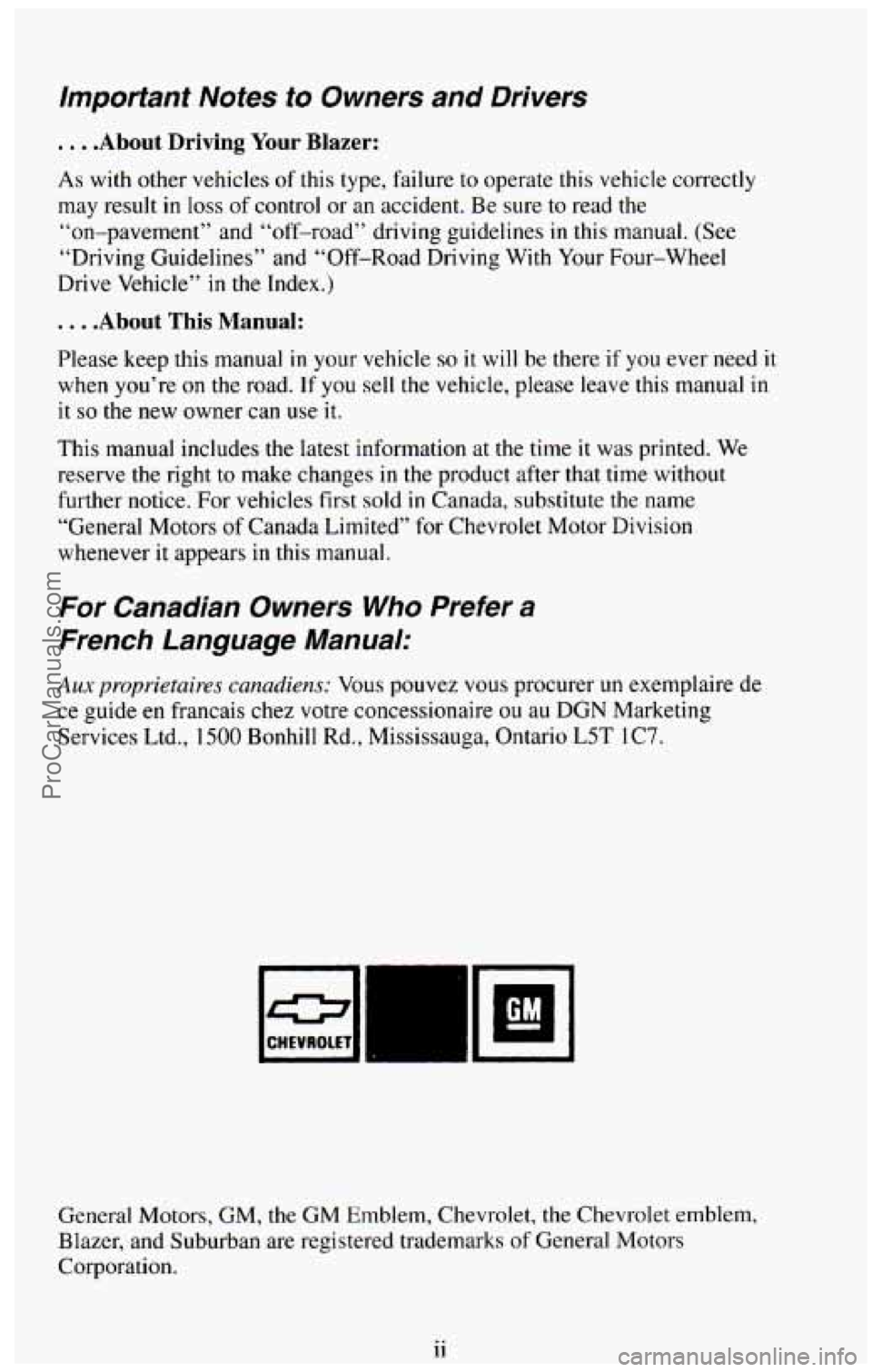
important Notes to Owners and Drivers
. . . .About Driving Your Blazer:
As with other vehicles of this type, failure to operate this vehicle correctly
may result
in loss of control or an accident. Be sure to read the
“on-pavement” and “off-road” driving guidelines
in this manual. (See
“Driving Guidelines” and “Off-Road Driving With Your Four-wheel
Drive Vehicle”
in the Index.)
. . . .About This Manual:
Please keep this manual in your vehicle so it will be there if you ever need it
when you’re on the road. If you sell the vehicle, please leave this manual in
it so the new owner can use it.
This manual includes the latest information at the time it was printed. We
reserve
the right to make changes in the product after that time without
further notice. For vehicles first sold
in Canada, substitute the name
“General Motors
of Canada Limited” for Chevrolet Motor Division
whenever it appears
in this manual.
For Canadian Owners Who Prefer a
French Language Manual:
Aux proprietuires canadiens: Vous pouvez vous procurer un exemplaire de
ce guide en francais chez votre concessionaire ou au DGN Marketing
Services Ltd.,
1500 Bonhill Rd., Mississauga, Ontario L5T lC7.
Ge.nera1 Motors, GM,
the GM Emblem, Chevrolet, the Chevrolet emblem,
Blazer, and Suburban are registered trademarks of General Motors
Corporation.
11 ..
ProCarManuals.com
Page 10 of 385
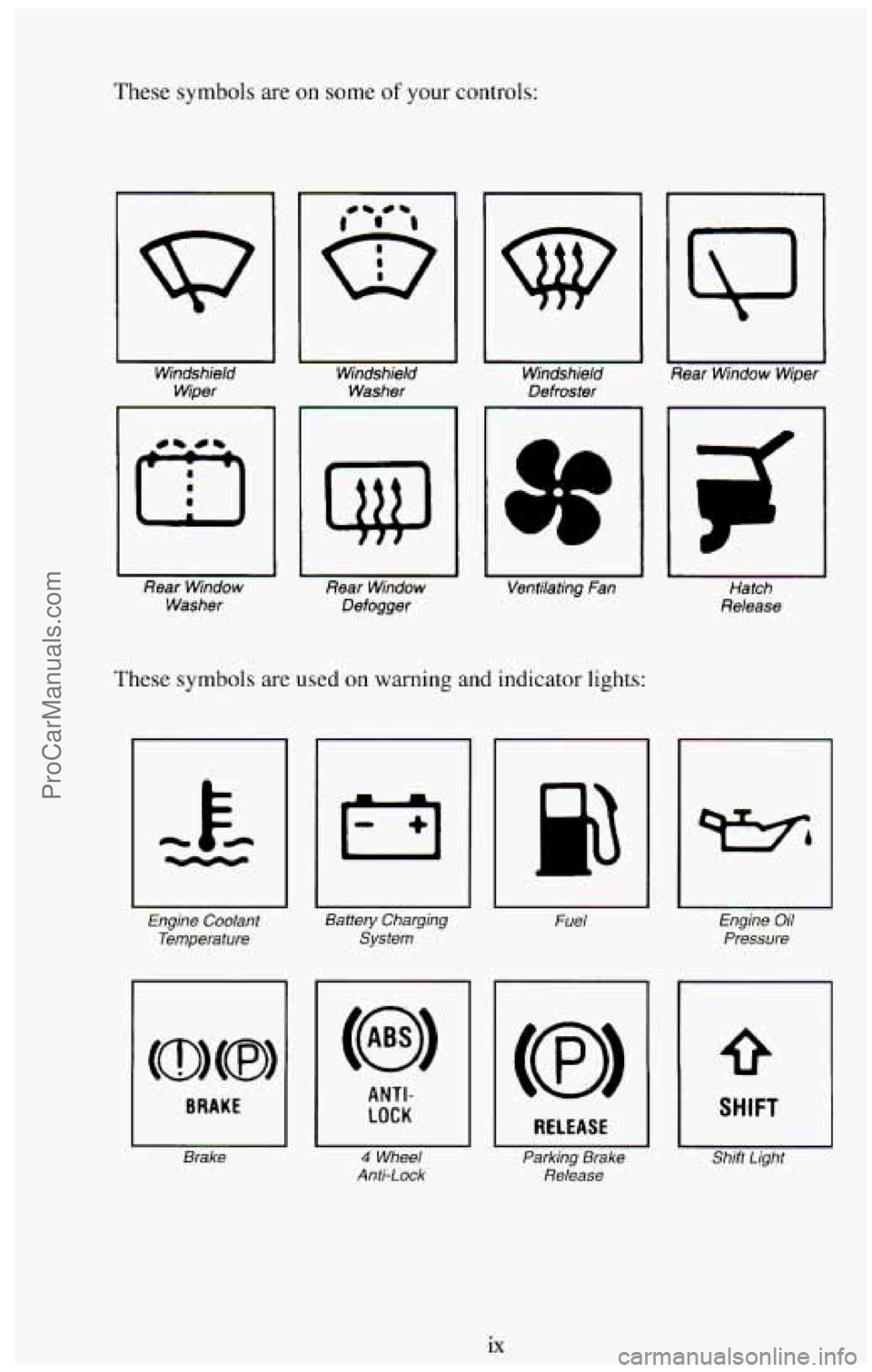
These symbols are on some of your controls:
I I Windshield Wiper
rl
i Rear Window
Washer Windshield
Washer Windshield
Defroster
1
3c
Rear
Window
Defogger Ventilating Fan
These symbols are used on
warning and indicator lights:
Engine Coolant
Temperature
BRAKE
I Brake
I p3
Baftery Charging
System
Fuel
ANTI-
I LOCK
I 4 Wheel
Anti-Lock
I RELEASE
Parking Brake Release
I\J
Rear Window Wiper
Hatch
Release
I
Engine Oil
Pressure
I SHIFT
1 Shift Light
ix
ProCarManuals.com
Page 26 of 385
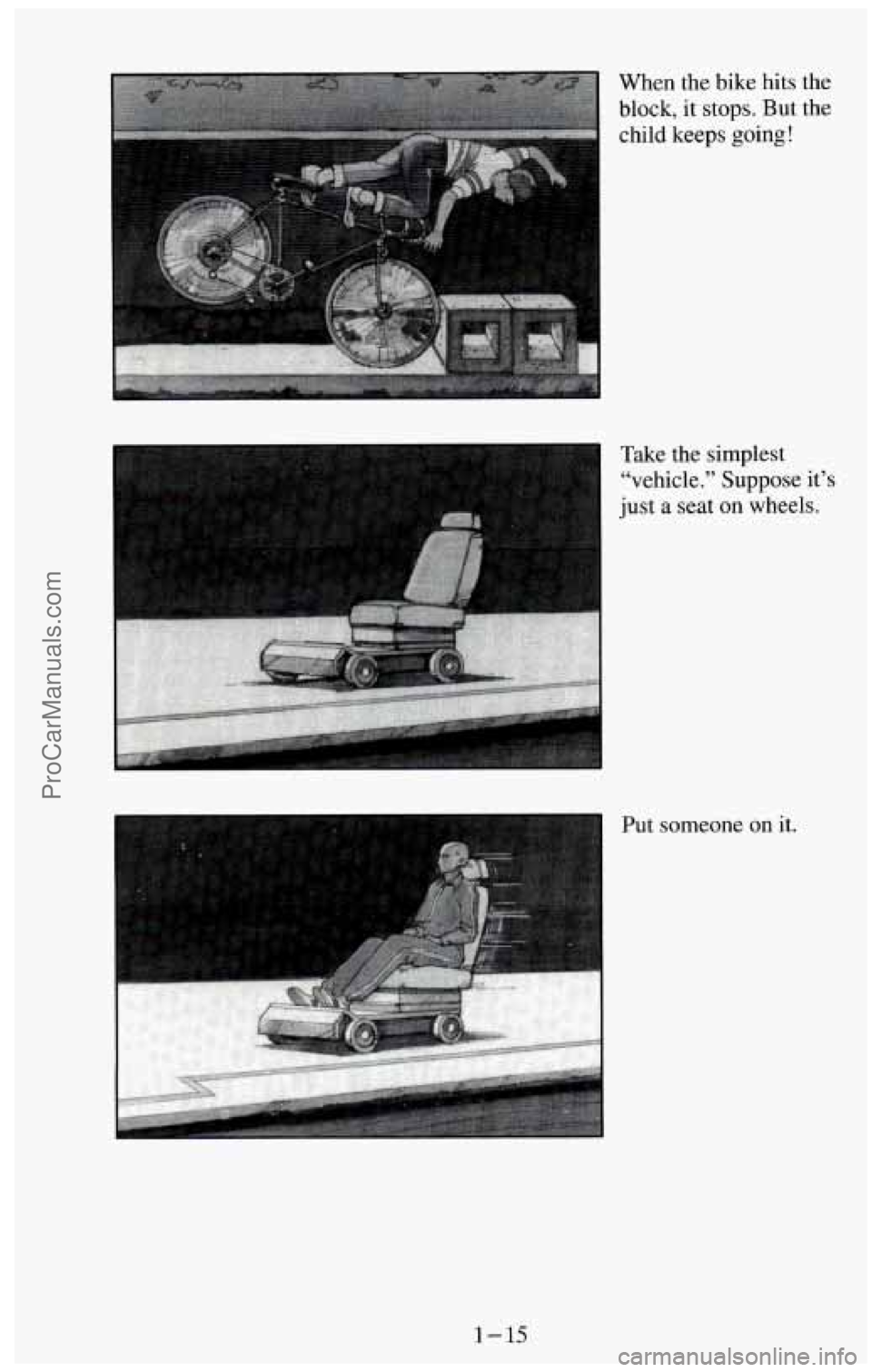
When the bike hits the
block, it stops. But the child keeps
going!
1
Take the simplest
“vehicle.” Suppose
it’s
just a seat on wheels.
. ....
Put someone on it.
1-15
ProCarManuals.com
Page 57 of 385
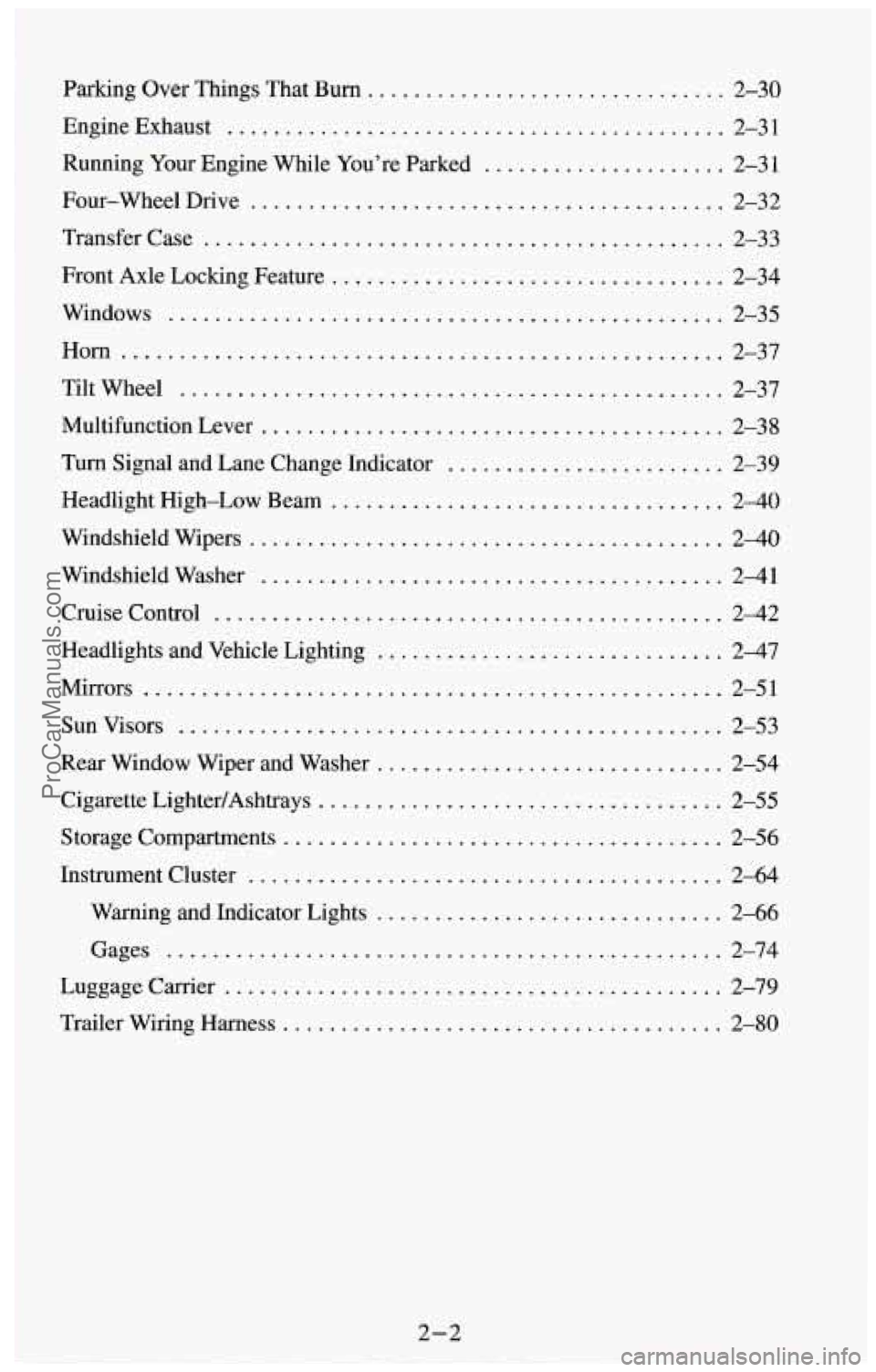
Parking Over Things That Burn ........................ ... 2-30
Running Your Engine While You’re Parked
..................... 2-31
EngineExhaust
........................................... 2-31
Four-WheelDrive
..................................... 2-32
Transfer Case
............................................. 2-33
Front Axle Locking Feature
.................................. 2-34
Windows
................................................ 2-35
Ho~ .................................................... 2-37
Tiltwheel
............................................. 2-37
Multifunction Lever
........................................ 2-38
Turn Signal and Lane Change Indicator
...................... 2-39
Windshield Wipers
......................................... 240
Headlight
High-Low Beam
................................ 2-40
Windshield Washer
........................................ 2-41
Cruise Control
........................................... 2-42
Headlights and Vehicle Lighting
.............................. 247
Mirrors
.................................................. 2-51
SunVisors
............................................... 2-53
Rear Window Wiper and Washer
.............................. 2-54
Storage Compartments
...................................... 2-56
Instrument Cluster
......................................... 2-64
Warning and Indicator Lights
.............................. 2-66
Luggagecarrier
........................................... 2-79
Trailer Wiring Harness
.................................... 2-80
Cigarette LightedAshtrays
............... ................ 2-55
Gages
................................................ 2-74
ProCarManuals.com
Page 65 of 385
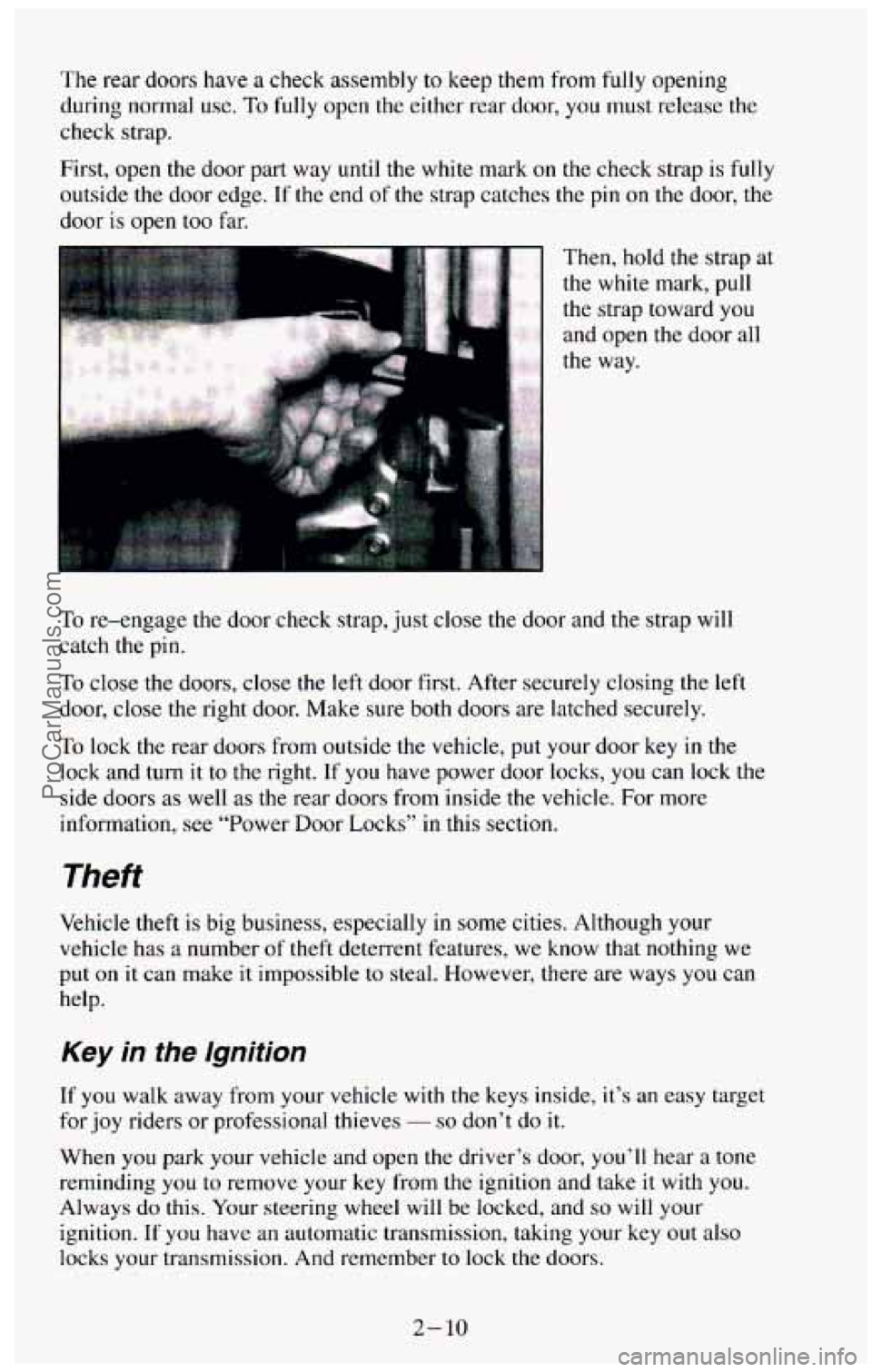
The rear doors have a check assembly to keep them from fully opening
during normal use.
To fully open the either rear door, you must release the
check strap.
First, open the door part way
until the white mark on the check strap is fully
outside the door edge. If the end of the strap catches the pin on the door, the
door is open too far,
Then, hold the strap at
the white mark, pull
the strap toward
you
and open the door all
the way.
To re-engage the door check strap, just close the door and the strap will
catch the pin.
To close the doors, close the left door first. After securely closing the left
door, close the right door. Make sure both doors are latched securely.
To lock the rear doors from outside the vehicle, put your door key in the
lock and turn it to the right. If you have power door locks, you can lock the
side doors as well as the rear doors from inside the vehicle. For more
information, see “Power Door Locks” in this section.
Theft
Vehicle theft is big business, especially in some cities. Although your
vehicle has a number of theft deterrent features, we
know that nothing we
put
on it can make it impossible to steal. However, there are ways you can
help.
Key in the lgnition
If you walk away from your vehicle with the keys inside, it’s an easy target
for
joy riders or professional thieves - so don’t do it.
When you park your vehicle and open the driver’s door, you’ll hear a tone
reminding
you to remove your key from the ignition and take it with you.
Always
do this. Your steering wheel will be locked, and so will your
ignition.
If you have an automatic transmission, taking your key out also
locks your transmission. And remember to lock the doors.
2- 10
ProCarManuals.com
Page 67 of 385
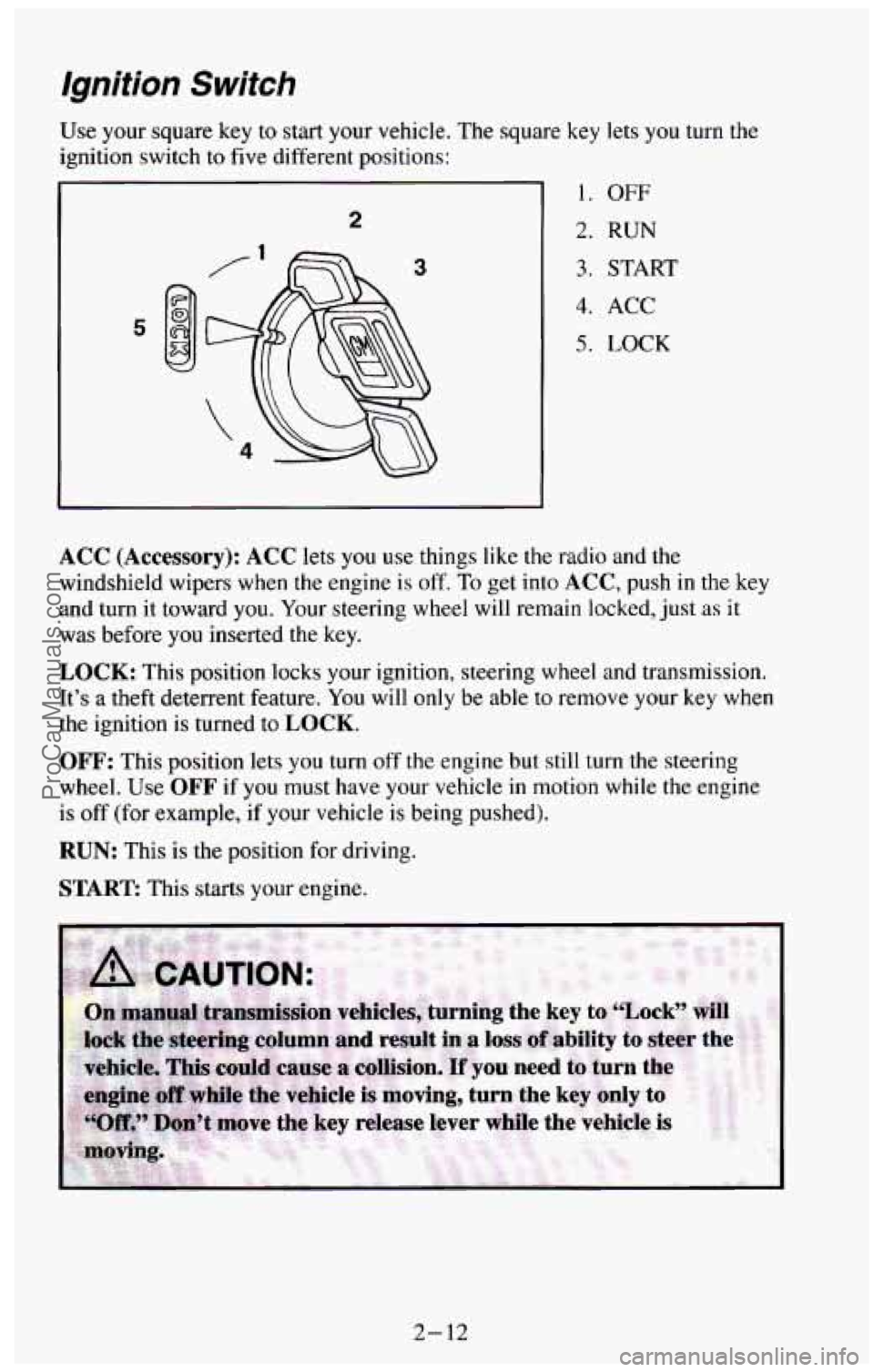
Ignition Switch
Use your square key to start your vehicle. The square key lets you turn the
ignition switch to five different positions: -
I
5
2
3
1. OFF
2. RUN
3. START
4. ACC
5. LOCK
ACC (Accessory): ACC lets you use things like the radio and the
windshield wipers when the engine is
off. To get into ACC, push in the key
and turn it toward you. Your steering wheel
will remain locked, just as it
was before
you inserted the key.
LOCK: This position locks your ignition, steering wheel and transmission.
It’s a
theft deterrent feature. You will only be able to remove your key when
the ignition is turned to LOCK.
OFF: This position lets you turn off the engine but still turn the steering
wheel. Use
OFF if you must have your vehicle in motion while the engine
is
off (for example, if your vehicle is being pushed).
RUN: This is the position for driving.
START This starts your engine.
2- 12
ProCarManuals.com
Page 68 of 385
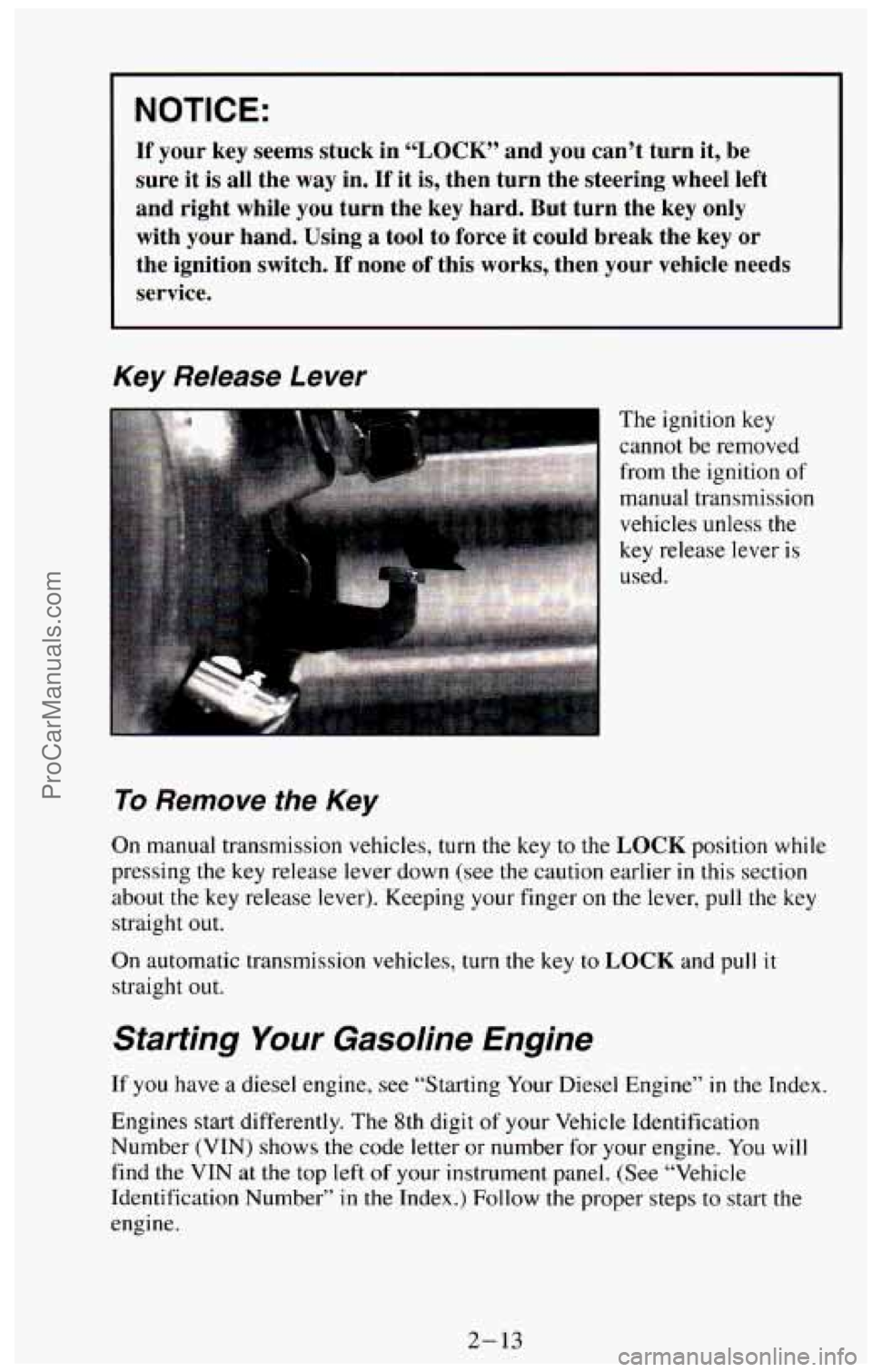
NOTICE:
If your key seems stuck in “LOCK” and you can’t turn it, be
sure it is all the way in.
If it is, then turn the steering wheel left
and right while
you turn the key hard. But turn the key only
with your hand. Using a tool to force
it could break the key or
the ignition switch.
If none of this works, then your vehicle needs
service.
Key Release Lever
The ignition key
cannot be removed
from the ignition of
.. manual transmission
vehicles unless the
To Remove the Key
On manual transmission vehicles, turn the key to the LOCK position while
pressing the key release lever down (see the caution earlier
in this section
about the key release lever). Keeping your finger
on the lever, pull the key
straight out.
On automatic transmission vehicles, turn the
key to LOCK and pull it
straight out.
Starting Your Gasoline Engine
If you have a diesel engine, see “Starting Your Diesel Engine” in the Index.
Engines start differently. The
8th digit of your Vehicle Identification
Number (VIN) shows the code letter or number for your engine.
You will
find the VIN at the top left of your instrument panel. (See “Vehicle
Identification Number” in
the Index.) Follow the proper steps to start the
engine.
2-13
ProCarManuals.com
Page 76 of 385

Automatic Transmission
There are several
different positions for
your shift lever.
0 P (Park)
This locks your rear wheels. It’s the best position to use when you start
your engine because your vehicle can’t move easily.
2-21
ProCarManuals.com
Page 77 of 385
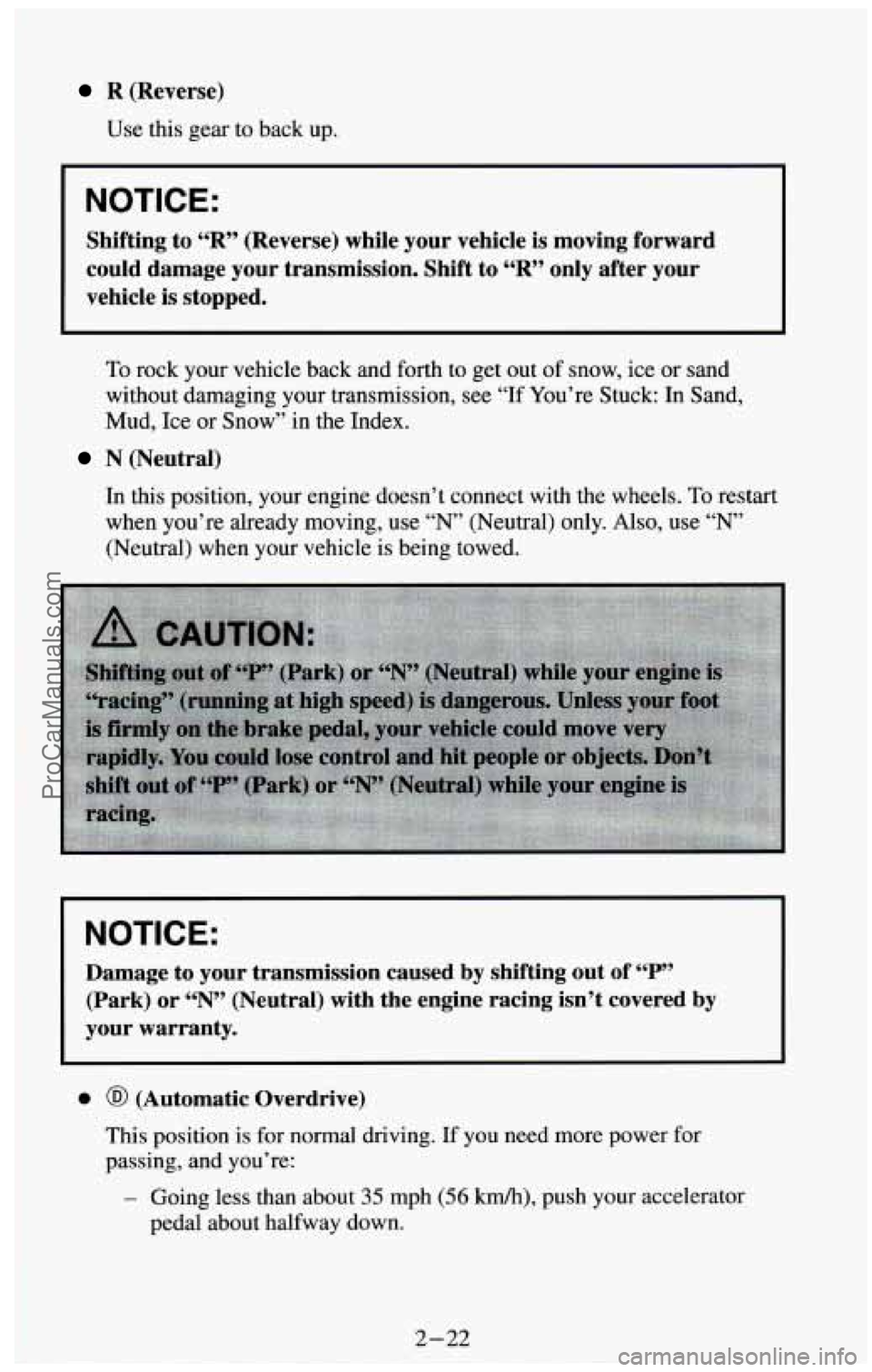
R (Reverse)
Use this gear to back up.
NOTICE:
Shifting to “R” (Reverse) while your vehicle is moving forward
could damage your transmission. Shift to
“R” only after your
vehicle is stopped.
To rock your vehicle back and forth to get out of snow, ice or sand
without damaging your transmission, see “If You’re Stuck: In Sand,
Mud, Ice or Snow’’
in the Index.
N (Neutral)
In this position, your engine doesn’t connect with the wheels. To restart
when you’re already moving, use
“N’ (Neutral) only. Also, use “N’
(Neutral) when your vehicle is being towed.
NOTICE:
Damage to your transmission caused by shifting out of “P”
(Park) or “N” (Neutral) with the engine racing isn’t covered by
your warranty.
0 @ (Automatic Overdrive)
This position is for normal driving. If you need more power for
passing, and you’re:
- Going less than about 35 mph (56 km/h), push your accelerator
pedal about halfway down.
I 2-22
ProCarManuals.com
Page 78 of 385
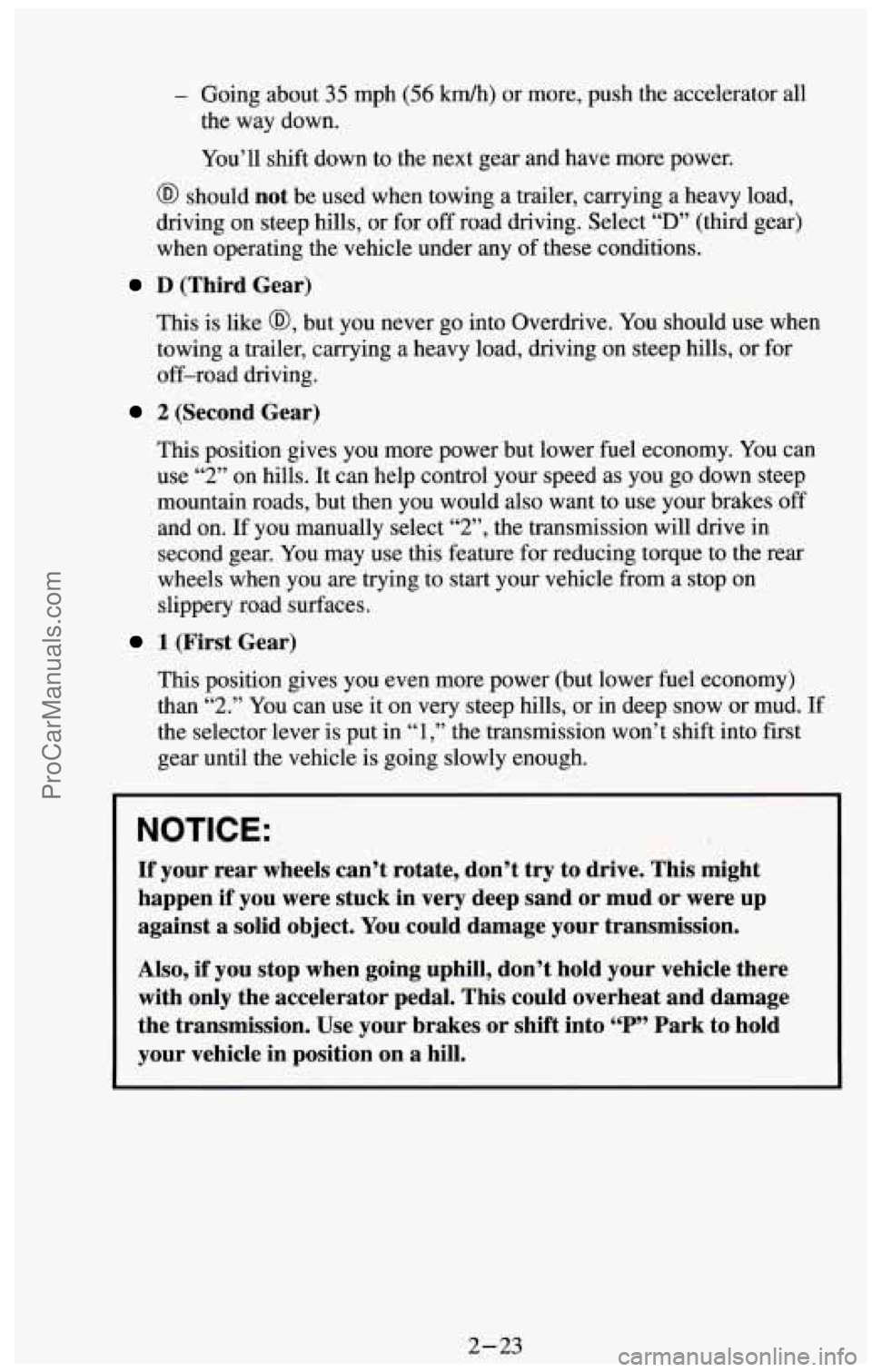
- Going about 35 mph (56 km/h) or more, push the accelerator all
the way down.
You’ll shift down to the next gear and have more power.
@ should not be used when towing a trailer, carrying a heavy load,
driving on steep hills, or for
off road driving. Select “D” (third gear)
when operating the vehicle under any of these conditions.
D (Third Gear)
This is like @, but you never go into Overdrive. You should use when
towing a trailer, carrying a heavy load, driving on steep hills, or for
off-road driving.
2 (Second Gear)
This position gives you more power but lower fuel economy. You can
use
“2” on hills. It can help control your speed as you go down steep
mountain roads, but then you would also want to use your brakes
off
and on. If you manually select “2”, the transmission will drive in
second gear.
You may use this feature for reducing torque to the rear
wheels when you are trying to start your vehicle from
a stop on
slippery road surfaces.
1 (First Gear)
This position gives you even more power (but lower fuel economy)
than
“2.” You can use it on very steep hills, or in deep snow or mud. If
the selector lever
is put in “1,” the transmission won’t shift into first
gear until the vehicle is going slowly enough.
NOTICE:
If your rear wheels can’t rotate, don’t try to drive. This might
happen if you were stuck in very deep sand or mud or were up
against
a solid object. You could damage your transmission.
Also, if you stop when going uphill, don’t hold your vehicle there
with only the accelerator pedal. This could overheat and damage
the transmission. Use your brakes
or shift into “P” Park to hold
your vehicle in position on
a hill.
2-23
ProCarManuals.com